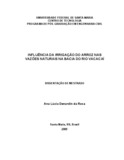| dc.creator | Rosa, Ana Lúcia Denardin da | |
| dc.date.accessioned | 2009-10-20 | |
| dc.date.available | 2009-10-20 | |
| dc.date.issued | 2009-08-20 | |
| dc.identifier.citation | ROSA, Ana Lúcia Denardin da. INFLUENCE OF IRRIGATION ON NATURAL FLOWS IN THE BASIN
OF VACACAÍ RIVER. 2009. 103 f. Dissertação (Mestrado em Engenharia Civil) - Universidade Federal de Santa Maria, Santa Maria, 2009. | por |
| dc.identifier.uri | http://repositorio.ufsm.br/handle/1/7731 | |
| dc.description.abstract | This study aimed to apply and assess the simplified methodology used by Paiva et al (2006 b) in the
basin of Vacacaí River, to obtain information about natural flows. The analyses were carried out based
on hydrological information and the use of geoprocessing techniques to determine the water demands of rice farming and to sub-divide the basin. The study of the use and the occupation of the soil showed that the flood plains of the Vacacaí River are covered by rice fields that occupy 8.06% of the basin area. Factors such as scarcity of rainfall data as well as uncertainty in the demand values adversity
affected the goodness of model fit, but it was possible to conclude that the methodology was really efficient in determining the natural flow of sub-basins with approximately 3456 km² of area, and that due to factors that were not considered in the model (e.g. spreading into rivers and storage purposes) it was not possible to obtain better results for sub-basins of larger dimensions. Among the ranges of discretized model, the ones which presented the best results were those with monthly generation and
propagation of flow as well as the generation of daily flow and propagation of 7 day average flow, highlighting the monthly simulation due to the smoothing of monthly maximum flows which were not well represented. According to the sensitivity analysis of the parameters of the monthly version model, the values of the parameter kkt showed no sensitivity to the functions studied (coefficient of Nash and Sutcliffe, peak discharge and change in the drained volume), differently from the parameters directly related to superficial flow, Sat and Pes, which were the most sensitive when the peak discharge was considered. From this research, it was concluded that in areas where the number of rice fields is higher the flows in the fluviometric stations are underestimated, the knowledge about natural flows by managers then becomes relevant. | eng |
| dc.description.sponsorship | Conselho Nacional de Desenvolvimento Científico e Tecnológico | |
| dc.format | application/pdf | por |
| dc.language | por | por |
| dc.publisher | Universidade Federal de Santa Maria | por |
| dc.rights | Acesso Aberto | por |
| dc.subject | Vazões naturais | por |
| dc.subject | Irrigação do arroz | por |
| dc.subject | Bacia do Rio Vacacaí | por |
| dc.subject | Natural flow | eng |
| dc.subject | Rice irrigation | eng |
| dc.subject | Basin of Vacacaí River | eng |
| dc.title | Influência da irrigação do arroz nas vazões naturais na bacia do Rio Vacacaí | por |
| dc.title.alternative | Influence of irrigation on natural flows in the basin of Vacacaí River | eng |
| dc.type | Dissertação | por |
| dc.description.resumo | Este estudo teve por objetivo aplicar e avaliar a metodologia simplificada proposta por Paiva et al (2006 b) na bacia do Rio Vacacaí, com vistas à obtenção de informações de vazões naturais. As análises foram realizadas através de informações hidrológicas e da utilização de técnicas de geoprocessamento para determinação das demandas hídricas das lavouras orizícolas e para subdivisão da bacia. O estudo do uso e ocupação do solo realizado mostrou que as várzeas do Rio
Vacacaí estão cobertas por lavouras orizícolas e que as mesmas ocupam 8,06% da área da bacia hidrográfica. Fatores como escassez de dados de chuva e incerteza nos valores de demanda adotados foram significantes para prejudicar a qualidade dos ajustes, entretanto foi possível perceber
que a metodologia mostrou-se bastante eficiente na determinação das vazões naturais de sub-bacais com aproximadamente 3.456 km² de área e que devido a fatores não considerados no modelo, como propagação em rios e efeitos de armazenamento, não foi possível obter melhores resultados para sub-bacias de maiores dimensões. Dentre os intervalos de discretização do modelo, os que apresentaram os melhores resultados foram aqueles com geração e propagação de vazões mensais e geração de vazões diárias e propagação das vazões médias de 7 dias, destacando a simulação mensal devido ao amortecimento das vazões máximas, as quais não foram bem representadas. A análise de sensibilidade dos parâmetros do modelo versão mensal, demonstrou que a constante de recessão Kkt não apresentou sensibilidade para as funções estudadas (coeficiente de Nash e Sutcliffe, vazão de pico e variação do volume escoado) diferentemente dos parâmetros que estão diretamente relacionados com escoamento superficial, Sat e Pes, que foram os mais sensíveis quando considerada a vazão de pico. Por meio da pesquisa foi possível comprovar que em áreas
onde há altos índices de lavouras de arroz, as vazões registradas nos postos fluviométricos são subestimadas, tornando-se importante para os gestores o conhecimento das vazões naturais. | por |
| dc.contributor.advisor1 | Paiva, Eloiza Maria Cauduro Dias de | |
| dc.contributor.advisor1Lattes | http://lattes.cnpq.br/9290923066819802 | por |
| dc.contributor.referee1 | Clarke, Robin Thomas | |
| dc.contributor.referee1Lattes | http://lattes.cnpq.br/4678882708966641 | por |
| dc.contributor.referee2 | Peiter, Márcia Xavier | |
| dc.contributor.referee2Lattes | http://lattes.cnpq.br/4072803412132476 | por |
| dc.creator.Lattes | http://lattes.cnpq.br/8845559512733339 | por |
| dc.publisher.country | BR | por |
| dc.publisher.department | Engenharia Civil | por |
| dc.publisher.initials | UFSM | por |
| dc.publisher.program | Programa de Pós-Graduação em Engenharia Civil | por |
| dc.subject.cnpq | CNPQ::ENGENHARIAS::ENGENHARIA CIVIL | por |


